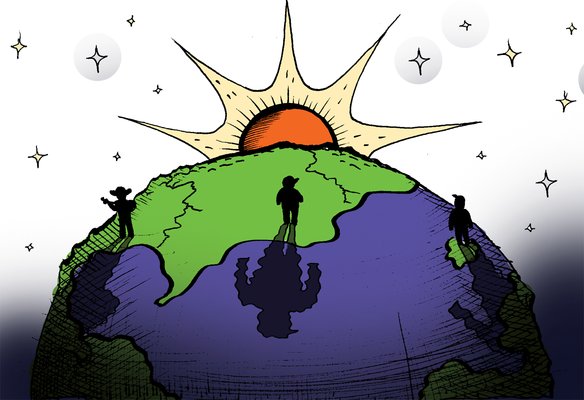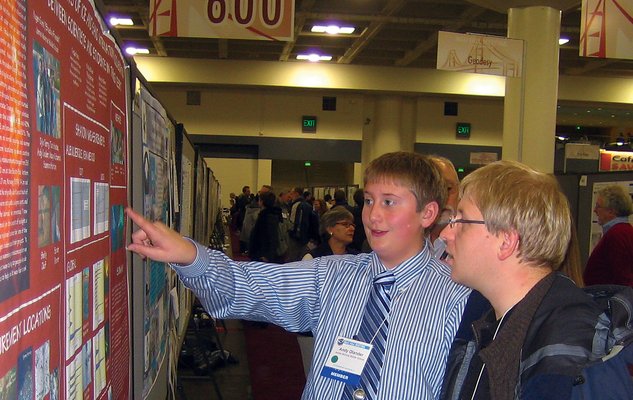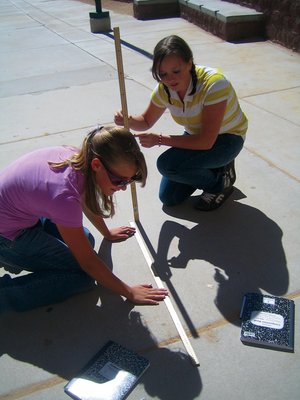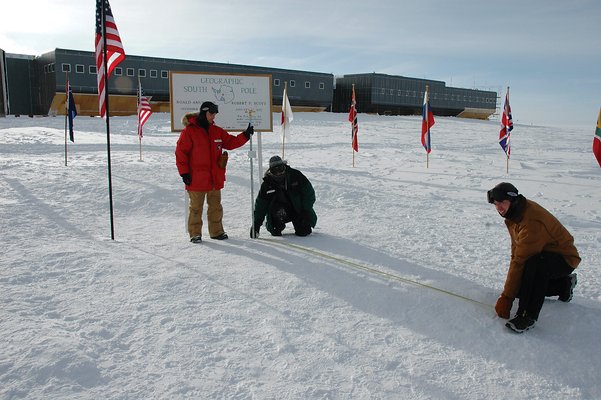
by Carolyn Gramling Thursday, January 5, 2012

Nate Burgess

Andy Olander explains his poster to scientists at the American Geophysical Union's annual meeting in December 2008. Turtle Haste

Shannon Hamilton (left) and Meagan Richards measure sun shadows. Turtle Haste

Scientists in Antarctica measure sun shadows cast by the pole marking the South Pole. Charlie Kaminski
Last December, in the enormous, fluorescent-lit hall of San Francisco’s Moscone Center South, thousands of geophysicists and geologists milled through dozens of aisles of poster displays, chatting enthusiastically about the latest in geophysical research at the annual meeting of the American Geophysical Union. Within each aisle, people clustered around the more intriguing displays, trying to hear more about a given researcher’s work. At the center of one such group, commanding his own audience, was the youngest scientist ever to present research at an AGU conference.
Middle-schooler Andy Olander, along with classmates Dylan Terry, Shannon Hamilton and Meagan Richards and science teacher Turtle Haste, all of James Monroe Middle School in Albuquerque, N.M., set out to test a simple hypothesis: that the length of shadows cast by the sun would increase in winter and decrease in summer. The experiment began as a small school project in mid-October 2007, but with data pouring in from scientists around the world — including at the South Pole — it turned into a unique, AGU-worthy collaboration.
The students designed their project in the best tradition of the scientific method — carefully proceeding from hypothesis to data collection to conclusions. The design of the project was simple: The students planted a one-meter-long stick in front of their school perpendicular to the ground, and measured the length of the shadows that it cast at noon once a week. They began their project after the autumnal equinox, the time of year when the sun is vertically above the equator and day and night are of about equal length. Shadows, they determined, should therefore change as the angle of the sun relative to the equator changes. “We predicted that as you get closer to the [winter] solstice, the shadows would get longer,” Olander says.
The winter solstice happened to be Olander’s birthday, he says — and that year, he got “a really good Christmas/birthday gift.” Through contacts at New Mexico Tech’s Mount Erebus Volcano Observatory, Haste got in touch with scientists at the Palmer and Amundsen-Scott research stations in Antarctica, who agreed to do their own parallel shadow-length measurements.
Following the middle school students’ experimental setup, the Antarctic researchers — Al Baker and Philip Spindler — planted their own meter-stick to measure sun shadows and calculate the sun’s angle relative to Earth. In December — at the solstice — the students and Antarctic scientists compared notes on their sun shadows via a satellite call.
In general, Olander says, shadow lengths were longer at the South Pole than in New Mexico, but as the angle of the sun decreased with the approach of the winter solstice, the lengths of shadows at all locations increased, supporting the students’ hypothesis.
After the winter solstice, both teams continued collecting measurements through the spring and summer. But the collaboration didn’t stop there: As news of the project spread with the help of U.S. Geological Survey collaborators and Haste’s blog updates on the International Polar Year’s Web site, more international partners got involved. They began submitting their own sun shadow data for the spring equinox from many more far-flung places, including China, Egypt, Norway and Russia, as well as locations across the United States, from Wisconsin to Colorado to California. The scientists who have participated in the experiment “have been absolutely fabulous,” Haste says.
Based on their winter solstice measurements, the New Mexico students made predictions for the spring measurements, and then compared them with the actual data. It may not be a cure for cancer, Haste commented on her IPY blog, but the collaborative project was a great learning experience for the students: One student was surprised to discover that the few degrees of latitude difference between Russia and Norway produce such a great difference in shadow length. The data from Egypt prompted another student, Haste noted, to think about the history of mathematics.
Meanwhile, more than a year after embarking on the project, Olander stood next to his poster in the Moscone Center, patiently fielding questions from the crowd gathered around him. “Science and math are my favorite subjects,” Olander said — and he was quickly learning not only the process of science, but also how to present research, from turning in an abstract to schmoozing with conference attendees. He was using the poster session, he said, to draw new collaborators into the project. “I’ve been picking up people throughout the day.”
But the experience wasn’t just about work, he added. “I’m enjoying myself.”
© 2008-2021. All rights reserved. Any copying, redistribution or retransmission of any of the contents of this service without the expressed written permission of the American Geosciences Institute is expressly prohibited. Click here for all copyright requests.